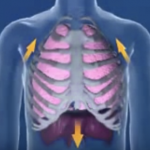Septum piercing refers to a kind of nose piercing that involves piercing the cartilage and bone wall present in the center of the nasal cavities. The wall is called the nasal septum. Septum piercing is not as popular as normal nostril piercing.
The Procedure
A small area occurs between the bottom part of the nose and the cartilage wall. This area features thin and soft skin and is the region where septum piercing is carried out.The jewelry is also fixed at this soft skin patch, just below the cartilage. As the tissue is flexible, the chances of any kind of dislodgement of the septum piercing jewelry is reduced.
Professional piercers typically use a piercing needle to perform a septum piercing. A septum may also be used on occasions. A scalpel may be used to create a bigger hole for septum piercing so that it can hold thicker or larger pieces of jewelry. Professionals will usually suggest a septum keeper or a ball closure ring as the first piece of jewelry; it can be changed once the piercing injury heals fully.
The process of piercing the septum can be painful and such pain may vary from mild to unbearable. It may also be accompanied by mild bleeding for about an hour as well as watering of the eyes.
Different kinds of jewelry can be used on the pierced septum. Some jewelry types include straight barbell, septum tusk, circular barbell, septum retainer, and septum spike, etc.It can be made of stainless steel, silver, gold, etc. Ensure that it is not made of metal that you may be allergic to.

Septum Piercing – Healing and Aftercare
Healing of septum piercing usually takes about 6 to 9 weeks. A larger piercing may take even longer to heal. The pierced area tends to be painful and tender to tender for the first few weeks after piercing. There may also be some soreness and redness.
Following the below listed aftercare guidelines, as recommended by the piercer or your doctor, can aid the healing process:
- Use a cotton ball dipped in saline water to clean the pierced area during a bath or shower. You may also use shampoo, soap, shower gel, etc., as suggested by the piercer to regularly clean the area. Later use paper towels to tap dry the area.
- A Q-tip dipped in saline solution may be used to remove crusts that may have developed around the pierced area. The same process may be used to clean dirt, crust, etc., off the jewelry as well.
- Avoid excessively touching or moving the jewelry on the septum during the period of healing. An unclean area coupled with excessive fidgeting with the jewelry can tear the pierced skin, cause intense pain, and leave it vulnerable to inflammation and infection.
- Do not blow the nose or press the nostrils during the healing period. Take care to prevent any accidental tugging at the septum piercing jewelry when wiping the face with a towel.
- Do not replace the jewelry on your own after healing. Consult the piercer and let him/her replace the jewelry for you.
- Do not use any alcohol-based cleansers. Sometimes, the piercer or doctor may suggest the use of creams or lotions or natural oils to promote the process of septum piercing healing. For example, you may apply a few drops of pure lavender essential oil on the area on a daily basis.
Septum Piercing – Infection
All piercings are susceptible to infections, but the septum piercings come with a significantly higher risk of infection.
- Infection of a septum piercing can occur due to poor hygiene; bad aftercare; use of jewelry made of metal that you are allergic to; use of a gun instead of a needle to pierce the septum; changing the jewelry before the pierced area has healed fully; swimming, especially in public pools, during the healing period; and use of cosmetics on the pierced site which end up clogging the pores and thus increase the risk to infections.
- It is easy to take care of mild infections of a septum piercing. Mild infections typically occur as a keloid or an infection bump with some soreness and redness. Basic care and above listed aftercare guidelines can help get rid of mild infections. If a septum piercing infection persists for more than a week, then patients need to consult a doctor.
- Infections that need medical attention usually start out as redness and tenderness in the pierced site. Patients may experience pain along with burning sensations at the affected area. In serious cases, the infection may be marked by discharge of grayish, yellow, or green pus from the septum piercing area. Some patients may also suffer from minor bleeding.
Treatment of septum piercing infections
Mild infections can be treated with the below listed self-care guidelines:
- Do not touch the infected region with dirty hands. Ensure that the area is always kept clean.
- Use water and an anti-bacterial soap and a cotton swab to clean the septum piercing infection. Later use lukewarm water to clean the surrounding area as well.
- Remove the jewelry if you are allergic to the metal. Go for jewelry made of another metal.
- Use an antiseptic ointment on the infected area before going out or sleeping.
- Abstain from caffeine or alcohol consumption as it can delay healing.
Consult a doctor in case of a severe septum piercing infection:
- Neomycin, bacitracin, or other antibacterial creams may be prescribed by the doctor for reduction of swelling and pain at the infection site.
- You physician may also recommend moderate use of tea tree oil or lavender oil on the affected skin.
- If the infection is very severe, oral antibiotics may be prescribed for a period of 3 to 5 days to destroy the bacteria.
Septum Piercing – Cost
The cost of septum piercing tends to vary as per the skill of the piercing technician and the location of the piercing studio. In most cases, the cost tends to fall in the range of $40 to $100. In addition to this, you may also need to pay the cost of the jewelry. The price of jewelry tends to differ as per the metal that you opt for.

